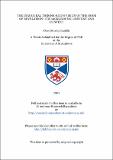Files in this item
The inaugural throne-room vision of the Book of Revelation : its background, content and context
Item metadata
| dc.contributor.author | Rankin, Dave Murray | |
| dc.coverage.spatial | 148 p. | en_US |
| dc.date.accessioned | 2018-05-22T13:29:06Z | |
| dc.date.available | 2018-05-22T13:29:06Z | |
| dc.date.issued | 2002 | |
| dc.identifier.uri | https://hdl.handle.net/10023/13460 | |
| dc.description.abstract | Our mandate in this thesis is in essence to tackle and complete two inter-linked, tripartite tasks. Firstly, the sources and traditions of the inaugural throne-vision of the Apocalypse (Rev. 4-5) will be considered; its contents and omissions will be closely examined; and its progressive context will be traced throughout the book with special attention being given to its relationship with the final eschatological vision (Rev. 21-22). Secondly, in parallel and in conjunction with these first three objectives, there is a further threefold consideration which stems from this primary analysis. This secondary concern will deal with the doctrine of God, the Christology of the Lamb, and the eschatological hope of the Christian. These tasks will serve to firmly anchor Revelation in its Jewish traditional background, and John's methods employed in handling these sources will be described. The comparison of the inaugural and the final throne-room visions will be made, and also their resemblance with and difference from other throne-room scenes will be highlighted. Finally John's theological messages, that develop from this, will be detailed. | en_US |
| dc.language.iso | en | en_US |
| dc.publisher | University of St Andrews | |
| dc.subject.lcc | BS2825.5R2 | |
| dc.subject.lcsh | Bible.--N.T.--Revelation.--Criticism, interpretation, etc. | en |
| dc.title | The inaugural throne-room vision of the Book of Revelation : its background, content and context | en_US |
| dc.type | Thesis | en_US |
| dc.type.qualificationlevel | Doctoral | en_US |
| dc.type.qualificationname | PhD Doctor of Philosophy | en_US |
| dc.publisher.institution | The University of St Andrews | en_US |
This item appears in the following Collection(s)
Items in the St Andrews Research Repository are protected by copyright, with all rights reserved, unless otherwise indicated.

